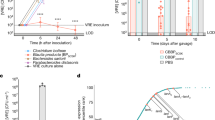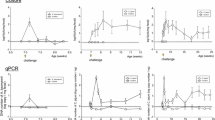Summary
In an attempt to restore the colonization resistance we administered anaerobic microflora to prevent an abnormal colonization of the intestine after antibiotic treatment had been discontinued. After the antibiotics had been discontinued and before the donor flora had been administered and had colonized the intestine, microorganisms present were “unopposed” and expanded to a high density. A mouse model was used to investigate which antibiotics negatively influenced the donor flora and reduced the colonization resistance when administered intraperitoneally. Erythromycin, clindamycin and carbenicillin suppressed the donor flora permanently, as could be seen by the reduced colonization resistance. Benzylpenicillin, ampicillin, doxycycline and the combination gentamicin-cephalothin affected the colonization resistance as long as these agents were present. Gentamicin alone and cephalothin and oxytetracycline had no effect on the colonization resistance.
Zusammenfassung
Zur Wiederherstellung der Kolonisationsresistenz wurde anaerobe Mikroflora verabreicht, die die anormale Kolonisation des Darmes nach Unterbrechung der Antibiotikatherapie verhindern sollte. In dem Zeitraum zwischen Unterbrechung der Antibiotikagabe und der Verabreichung und dem Angehen der Spenderflora im Darm konnten sich bereits anwesende Mikroorganismen ungehindert in großer Dichte ausbreiten. In einem Mäusemodell wurde geprüft, welche Antibiotika bei intraperitonealer Gabe die Spenderflora negativ beeinflußten und die Kolonisationsresistenz verminderten. Erythromycin, Clindamycin und Carbenicillin führten zu einer anhaltenden Unterdrückung der Mikroflora, wie sich an der verminderten Kolonisationsresistenz ableiten ließ. Benzylpenicillin, Ampicillin, Doxycyclin und die Kombination Gentamicin-Cephalotin beeinträchtigten die Kolonisationsresistenz so lange wie diese Substanzen anwesend waren. Gentamicin allein und Cephalotin und Oxytetracyclin hatten keinen Einfluß auf die Kolonisationsresistenz.
Similar content being viewed by others
Literature
Hendriks, W. D. H., Vast, J. de, Waaij, D. van der Gastrointestinal decontamination and reverse isolation in healthy monkeys. Infection 9 (1981) 142–148.
Bodey, G. P., Gehan, E. A., Freireich, E. J., Frei, E. Protected environment-prophylactic antibiotic program in the chemotherapy of acute leukemia. Am. J. Med. Sci. 262 (1971) 138–151.
Levi, J. A., Vincent, P. C., Jennis, F., Lind, D. E., Gunz, F. W. Prophylactic oral antibiotics in the management of acute leukaemia. Med. J. Aust. 1 (1973) 1025–1029.
Levine, A. S., Siegel, S. E., Schreiber, A. D., Hauser, J., Preisler, H., Goldstein, I. M., Seidler, F., Simon, R., Perry, S., Bennett, J. E., Henderson, E. S. Protected environments and prophylactic antibiotics. N. Engl. J. Med. 288 (1973) 477–483.
Yates, J. W., Holland, J. F. A controlled study of isolation and endogenous microbial suppression in acute myelocytic leukemia patients. Cancer 32 (1973) 1490–1498.
Schimpff, S. C., Greene, W. H., Young, V. M., Fortner, C. L., Jepsen, L., Cusack, N., Block, J. B., Wiernik, P. H. Infection prevention in acute nonlymphocytic leukemia. Ann. Intern. Med. 82 (1975) 351–358.
Dietrich, M., Gaus, W., Vossen, J., Waaij, D. van der, Wendt, F. Protective isolation and antimicrobial decontamination in patients with high susceptibility to infection. Part I: Clinical Results. Infection 5 (1977) 107–114.
Waaij, D. van der, Berghuis-de Vries, J. M., Lekkerkerk-van der Wees, J. E. C. Colonization resistance of the digestive tract in conventional and antibiotic treated mice. J. Hyg. 69 (1971) 405–411.
Raibaud, P., Ducluzeau, R., Ghnassia, J. C., Griscelli, C., Lauvergeon, B., Mocquot, G. Etablissement d'une flore microbienne dans le tube digestif d'enfants axéniques élevés en isolateur. Rev. Franc. Gynécol. 70 (1975) 579–583.
Dietrich, M., Fliedner, Th. M. Gnotobiotic care of patients with immunologic deficiency diseases. Transplant. Proc. 3 (1973) 1271–1277.
Vossen, J. M., Waaij, D. van der Recolonization after decontamination: clinical experiences. In:J. F. Ph., Winkler, K. C. (eds.): Airborne transmission and airborne infection. Utrecht (The Netherlands), Oosthoek 1973, pp. 549–553.
Waaij, D. van der, Heidt, P. J. Intestinal bacterial ecology in relation to immunological factors and other defense mechanisms. In:Hambreaus, L., Hanson, L. A., Mcfarlane, H. (eds.): Food and immunology. Proc. XIII Symp., Swedish Nutrition Foundation, Almqvist and Wiksell, Stockholm 1977, pp. 133–141.
Waaij, D. van der, Berghuis, J. M., Lekkerkerk, J. E. C. Colonization resistance of the digestive tract of mice during systemic antibiotic treatment. J. Hyg. Camb. 70 (1972) 605–610.
Trexler, P. C. Flexible wall plastic film isolators. Proc. 2nd Symp. Gnotobiotic Technology. Univ. Notre Dame Press, Notre Dame Indiana, 1960, pp. 55–60.
Waaij, D. van der, Andreas, A. H. Prevention of airborne contamination and cross-contamination in germ-free mice by laminar flow. J. Hyg. Camb. 69 (1971) 83–89.
Radl, J., Berg, P. van den, Voormolen, M., Hendriks, W. D. H., Schaefer, U. W. Homogeneous immunoglobulins in sera of rhesus monkeys after lethal irradiation and bone marrow transplantation. Clin. Exp. Immunol. 16 (1974) 259–265.
Heilmeyer, W. Antibiotica Fiebel. Georg Thieme, Stuttgart 1969, p. 220.
Sutter, V. L., Finegold, S. M. Susceptibility of anaerobic bacteria to 23 antimicrobial agents. Antimicrob. Agents Chemother. 10 (1976) 736–752.
Heilmeyer, W. Antibiotica Fiebel. George Thieme, Stuttgart 1969, p. 274.
Heilmeyer, W. Antibiotica Fiebel. George Thieme, Stuttgart 1969, p. 293.
Garrod, L. P., Lambert, H. B., O'Grady, F. Antibiotic chemotherapy. Churchill and Livingstone, Edinburgh/London 1973, p. 152.
Heilmeyer, W. Antibiotica Fiebel. George Thieme, Stuttgart 1969, p. 429.
Hendriks, W. D. H.: Unpublished observations.
Author information
Authors and Affiliations
Rights and permissions
About this article
Cite this article
Hendrik, W.D.H., de Vas, J. & van der Waaij, D. Recontamination after gastrointestinal decontamination with non-absorbable antibiotics. Infection 9, 228–232 (1981). https://doi.org/10.1007/BF01640721
Received:
Published:
Issue Date:
DOI: https://doi.org/10.1007/BF01640721




